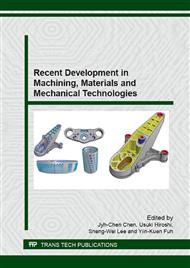p.220
p.226
p.231
p.237
p.243
p.251
p.255
p.261
p.266
Effects of Cutting Fluid Application in the Performance of the Nimomic 80A Turning
Abstract:
The increase of world requirements for improved products joined to growing competition between companies in the global market makes the same seek processes that ensure lower costs allied to high productivity and high quality product. Therefore, the great industrial and technological development has been increased the search for machining processes that promote, for example, high performance as regards the chip removal, less tool wear, failure and reduced impact on the environment. Regarding nickel-based superalloys, they have an extremely important role in the aeronautical and automotive industries among others. The nickel-based superalloy studied is the Nimonic 80A, hard machine material that has high mechanical strength and corrosion resistance on higher temperatures. The objective of this report is to study the influence of the application of cutting fluids in turning and the machining parameters in order to achieve high performance and optimization of machining this alloy. This one was machined using various machining parameters: cutting speed, feed rate, cutting depth, Minimum Quantity fluid (MQF), and Fluid abundant. After turning chip samples were obtained, was measured the surface roughness, volume of chip removed, cutting length and macro structural, some analyzes were performed and of lifetime of the tools were used in order to detect possible wear, as well as, microstructural observation of the chips by optical microscopy, scanning electron microscopy (SEM) and energy dispersive spectroscopy (EDS).On this report, we can observe the behavior of the materials and tools in the two cooling conditions used, and also, the impacts of the parameter variations in the surface finish, on the structure of the material and performance of the tools in respect chip removal regarding volume removed and machined length. Application by MQF was promising, but there is an abundant beyond the traditional application.
Info:
Periodical:
Pages:
243-250
Citation:
Online since:
July 2015
Authors:
Keywords:
Price:
Сopyright:
© 2015 Trans Tech Publications Ltd. All Rights Reserved
Share:
Citation:


